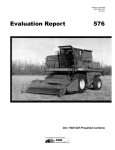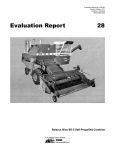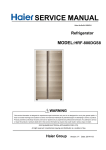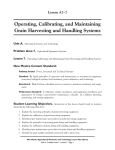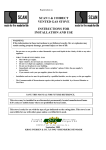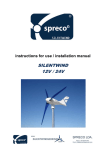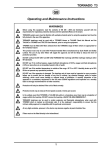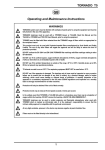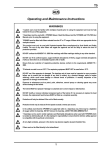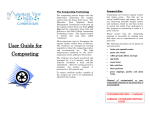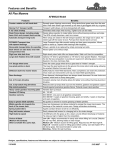Download EVALUATION REPORT 364
Transcript
Printed: May, 1984 Tested at: Humboldt ISSN 0383-3445 Group 4c EVALUATION REPORT 364 SPERRY NEW HOLLAND TR85 SELF-PROPELLED COMBINE A Co-operative Program Between ALBERTA FARM MACHINERY RESEARCH CENTRE PAMI PRAIRIE AGRICULTURAL MACHINERY INSTITUTE SPERRY NEW HOLLAND TR85 SELF-PROPELLED COMBINE MANUFACTURER: Sperry New Holland Division of Sperry Rand Corporation New Holland, Pennsylvania 17557 RETAIL PRICE: $123,300 (May, 1984, f.o.b. Humboldt, with a 13 ft (4.0 m) header, 10 ft (3.0 m) Victory pickup, variable spewed feeder, feeder jack stand, high speed rotor kit, straw spreaders, 28L x 26 R1 drive tires, 11 x 16 F2 steering tires, grain loss monitor, starting uid injector kit, block heater, radio, cab heater, windshield wiper, and service oodlight). DISTRIBUTORS: Sperry New Holland P.O. Box 777 Winnipeg, Manitoba R3C 2L4 Sperry New Holland P.O. Box 1907 Regina, Saskatchewan S4N 2S3 Sperry New Holland P.O. Box 1616 Calgary, Alberta T2P 2M7 FIGURE 1. Sperry New Holland TR85: (1) Rotors, (2) Threshing Concave, (3) Separating Concave, (4) Discharge Beater, (5) Beater Grate, (6) Cleaning Shoe, (7) Stone Ejection Roller, (8) Tailings Return. SUMMARY AND CONCLUSIONS Capacity: In the capacity tests, the MOG Feedrate* at 3% total grain loss was 450 and 650 lb/min (12.3 and 17.7 t/h) in Bonanza barley. In wheat, at power limit, total loss reached only 1.2% of yield in Columbus and 2.0% in Neepawa. The MOG Feedrates at these loss levels were 560 lb/min (15.3 t/h) in Neepawa and 590 lb/min (16.1 t/h) in Columbus. In barley crops at 3% total grain loss, the Sperry New Holland TR85 had approximately 2 times the capacity of the Machinery Institute reference combine. In wheat, the maximum feedrates achieved by the Sperry New Holland TR85, at less than 2% total grain loss, were about 1.4 to 1.7 times those of the reference combine at 3% total grain loss. Quality of Work: Pickup performance was good in all crops. It picked cleanly at speeds up to 6 mph (9.6 km/h) and fed the crop evenly under the table auger. Feeding was good for most crops, however, the table auger plugged frequently in bunchy windrows. The feeder backfed occasionally in rye crops especially at the lower feeder speeds. Optimum rotor feeding occurred in double *MOG Feedrate (Material-Other-than-Grain Feedrate) is the mass of straw and chaff passing through the combine per unit time. Page 2 side-by-side windrows and wide loosely formed windrows. The powered stone roller and trap door provided good protection from stones, roots, and large wads. Threshing was very good. The Sperry New Holland TR85 threshed very aggressively and completely in all crops and had less grain damage than the reference combine. Straw breakup was much greater than for the reference combine, in tough conditions, the maximum feedrate was greatly reduced due to increased power requirements. The rotors and concaves vibrated severely at medium to high feedrates. The Sperry New Holland TR85 had very good separation in all crops. Rotor loss was low over the entire operating range and did not limit capacity. Cleaning shoe performance was very good. Capacity was good and grain loss over the shoe was low. when properly adjusted, the grain sample was clean in all crops encountered. Grain handling was fair. The 205 bushel (7.5m³) grain tank lled evenly and completely in all crops. Unloading was slow, taking about 198 seconds to unload a full tank of dry wheat. Unloader discharge height was effectively reduced by the optional downspout. Straw spreading was good. The straw spreaders spread the straw evenly over about 16 ft (4.9 m). Ease of Operation and Adjustment: Operator comfort in the Sperry New Holland TR85 was fair. Operator comfort was reduced by the loud cab noise caused by rotor and concave vibration when harvesting. The cab was relatively dust free. The heater and air conditioner provided comfortable cab temperatures. The seat and steering column could be adjusted to suit most operators. The cab windows provided clear visibility forward and to the sides. The view of the incoming windrow was partially blocked. The rear view mirrors did not provide adequate depth perception. Instrumentation was good. They monitored most important functions and had built-in warning systems. They worked well and were helpful. The digital display and loss monitor were inconvenient to view while harvesting, Controls were good. Most controls were conveniently located, responsive, and easy to use. Loss monitor performance was fair. Only shoe loss was monitored and since shoe loss was usually very low, it was of little use. The reading was only meaningful if compared to actual losses observed at various loss levels. Lighting for night time harvesting was good, although the upper console did not have adequate lighting. The warning ashers were not clearly visible from behind during the day. Handling was good. Although the steering was moderately stiff the combine steered well and was very maneuverable in the eld and on the road. Ease of adjusting the combine components was good, while ease of setting them to suit crop conditions was very good. The return tailings were inconvenient to check. Ease of unplugging was fair. The rotors were dif cult to access. The table auger was inconvenient to reverse. Ease of cleaning was fair. Dirt and chaff collected under the engine and on top of the rotor housing. Chaff and dirt had to be cleaned regularly from behind the rasp bars. Ease of lubrication was good. The fuel inlet was high. Most grease ttings were easily accessible. Ease of performing most general maintenance and repair was good. Engine and Fuel Consumption: The engine started easily and ran well. It had adequate power for easy-to-thresh crops but was underpowered for hard-to-thresh crops. Its average fuel consumption for the season was about 6.7 gal/h (30.4 L/h). Oil consumption was signi cant but not excessive. Operator Safety: Operator safety was good. The Sperry New Holland TR85 was safe to operate if normal safety precautions were taken and warnings heeded. Operator Manual: The operator manual was good. It provided much useful information but had several incorrect references. Mechanical History: A few mechanical problems occurred during the test. RECOMMENDATIONS It is recommended that the manufacturer consider: 1. Modi cations to reduce threshing vibration and prevent material build-up behind the rasp bars. 2. Modi cations to provide positive locking of the grain tank extensions. 3. Modi cations to provide faster grain unloading. 4. Supplying additional rear view mirrors to improve depth perception. 5. Relocating the digital display for more convenient observation while harvesting. 6. Improving upper console lighting. 7. Modi cations to improve the ease of adjusting the stone ejection roller. 8. Modi cations to improve the ease of adjusting the chaffer extension sieve. 9. Supplying a safe, more convenient apparatus for sampling the return tailings while harvesting. 10. Modi cations to provide convenient header unplugging. 11. Modi cations to improve visibility of the warning/signal lights from the rear. 12. Including feeder house removal instructions in the operator manual. 13. Revising the operator manual to clearly identify all lubrication points and to correct referencing errors. 14. Correcting the suggested chaffer sieve and cleaning sieve settings for wheat. 15. Modi cations to improve the ease of header drive belt removal and installation. 16. Modi cations to protect the header wiring harness. Senior Engineer: G. E. Frehlich Project Manager: L. G. Hill Project Technologist: R. M. Bartel THE MANUFACTURER STATES THAT With regard to recommendation number: 1. Future models will have a new rotor design, which will greatly reduce vibration and material build-up behind the rasp bars. 2. Changes to the locking device on the grain tank extensions are being considered. 3. Faster grain unloading is being evaluated for future models. 4. Different types and con gurations of mirrors are being evaluated and will be introduced on future models. 5. The digital display will be relocated on future models. 6. Improved console lighting will be incorporated on future models. 7. We will consider changing this. 8. We will consider changing this. 9. No changes are planned. 10. A feeder and header reverser will be available in the very near future. 11. Changes will be made in this area on future models. 12. These instructions will be included in a revised manual. They are presently included in the Service Manual. 13. These areas will be corrected in the revised manual. 14. Suggested settings will be revised in the new manual. 15. This area has been redesigned beginning with 1984 productions. 16. The wire harness has been rerouted beginning with the 1984 productions. GENERAL DESCRIPTION The Sperry New Holland TR85 is a self-propelled combine with two longitudinally-mounted rotors, threshing and separating concaves, discharge beater and a cleaning shoe. Threshing occurs mainly at the front section of the rotors while separation of grain from straw occurs throughout the full length of the threshing and separating concaves and at the rear beater grate. The grain is cleaned at the shoe and the return tailings delivered to the front of the rotors. A stone ejection roller is mounted within the feeder housing. The test machine was equipped with a 175 hp (131 kW) eight cylinder, naturally aspirated, diesel engine, a 13 ft (4.0 m) header, a 10 ft (3.0 m) Victory pickup, a straw spreader, and other optional equipment listed on page 2. The Sperry New Holland TR85 has a pressurized operator cab, power steering, hydraulic wheel brakes, and a hydrostatic traction drive. The separator, header and unloading auger drives are manually engaged. Header height and unloading auger swing are hydraulically controlled. Rotor, pickup, cleaning fan and feeder speeds and concave clearance are adjusted from within the cab. Cleaning shoe settings are adjusted on the machine. There is no provision to safely and conveniently inspect the return tailings while operating. Important component speeds and machine and harvest functions are displayed on electronic monitors. Detailed speci cations are given in APPENDIX I. SCOPE OF TEST The Sperry New Holland TR85 was operated for 176 hours while harvesting about 1540 ac (623 ha) of various crops. The crops and conditions are shown in TABLES 1 and 2. During the harvest, it was evaluated for rate of work, quality of work, ease of operation and adjustment, operator safety, and suitability of the operator manual. Mechanical failures were recorded. Page 3 TABLE 1. Operating Conditions Crop Variety Average Yield Swath Width bu/ac t/ha ft m Hours Field Area ac ha Barley Barley Bonanza Conquest 44 50 2.4 2.7 22, 28 30 6.7, 8.5 9.1 24.5 8.0 211 77 85 31 Rapeseed Rapeseed Rapeseed Rapeseed Andor Regent Tobin Tower 22 21 20 17 1.2 1.2 1.1 1.0 18 22 20 28 5.5 6.7 6.1 8.5 11.5 12.0 4.0 6.5 98 98 36 59 40 40 15 24 Rye Rye Frontier Puma 14 22 0.9 1.4 20 20, 22, 24, 50 6.1 6.1, 6.7, 7.3, 15.2 16.0 124 50 52.5 498 201 Wheat Wheat Columbus Neepawa 29 30 2.0 2.0 42 25, 28, 30, 41, 48 12.8 7.6, 8.5, 9.1, 12.5, 14.6 2.0 26 10 39.0 313 127 176.0 1540 623 Total TABLE 2. Operation in Stony Conditions Field Area (ha) Field Condition Hours ac ha Stone Free Occasional Stones Moderately Stony 56 88 32 486 763 291 197 309 117 Total 176 1540 623 Reference Combine: It is well recognized that a combine’s capacity may vary considerably due to crop and weather conditions (APPENDIX II AND FIGURES 24 and 25). Since these conditions affect combine performance, it is impossible to compare combines that are not tested under identical conditions. For this reason, the Machinery Institute uses a reference combine. It is simply one combine that is tested each time that an evaluation combine is tested. Since conditions are similar the combine can be compared directly to the reference combine and a relative capacity determined. Combines tested in different years and conditions can then be compared indirectly using their relative capacities. RATE OF WORK Capacity Test Results: The capacity results for the Sperry New Holland TR85 at 3% loss are summarized in TABLE 3. The performance curves for the capacity tests are presented in FIGURES 2 to 5. The curves in each gure indicate the effect of increased feedrate on rotor loss, shoe loss, unthreshed loss, and total loss. From the graphs, combine capacity can also be determined for loss levels other than 3%. These results were obtained with the combine set for optimum performance at a reasonable feedrate. RESULTS AND DISCUSSION TERMINOLOGY MOG, MOG Feedrate, Grain Feedrate and MOG/G Ratio: A combine’s performance is affected by two main factors; the amount of straw and chaff being processed and the amount of grain or seed being processed. The straw, chaff, and plant material other than the grain or seed is called MOG, which is an abbreviation for “MaterialOther-than-Grain”. The quantity of MOG being processed per unit of time is called the “MOG Feedrate”. Similarly the amount of grain being processed per unit of time is called the “Grain Feedrate”. The MOG/G ratio, which is the MOG Feedrate divided by the Grain Feedrate, indicates how dif cult a crop is to separate. For example, MOG/G ratios for prairie wheat crops may vary from 0.5 to 1.5. In a crop with a 0.5 MOG/G ratio, the combine has to handle 50 lbs (22.7 kg) of straw for every 100 lbs (45.4 kg) of grain harvested. However, in a crop with a 1.5 MOG/G ratio, for a similar 100 lbs (45.4 kg) of grain harvested the combine now has to handle 150 lbs (68.2 kg) of straw -- 3 times as much. Therefore, the higher the MOG/G ratio, the more dif cult it is to separate the grain. Grain Loss, Grain Damage and Dockage: Grain loss from a combine can be of two main types; Unthreshed Loss consisting of grain left in the head and discharged with the straw and chaff, or Separator Loss which is free (threshed) grain discharged with the straw and chaff. Separator Loss can be further de ned as shoe and walker (or rotor) loss depending where it came from. Loss is expressed as a percentage of the total amount of grain being processed. Damaged or cracked grain is also a form of grain loss. In this report the cracked grain is determined by comparing the weight of actual damaged kernels to the entire weight of the sample taken from the grain tank. Dockage is determined by standard Grain Commission methods. It consists of large foreign particles and smaller particles that pass through a screen speci ed for that crop. It is expressed as a percentage of the total sample taken. Capacity: Combine capacity is the maximum rate at which a combine, adjusted for optimum performance, can process crop material at a certain total loss level. The Machinery Institute expresses capacity in terms of MOG Feedrate at 3% total loss. Although MOG Feedrate is not as easily visualized as Grain Feedrate, it provides a much more consistent basis for comparison. A combine’s ability to process MOG is relatively consistent even if MOG/G ratios vary widely. Three percent total loss is widely accepted in North America as an average loss rate that provides an optimum trade-off between work accomplished and grain loss. This may not be true for all combines nor does it mean that they cannot be compared at other loss levels. Page 4 FIGURE 2. Grain Loss in Bonanza Barley (A). FIGURE 3. Grain Loss in Bonanza Barley (B). FIGURE 4. Grain Loss in Columbus Wheat (C). TABLE 3. Capacity of the Sperry New Holland TR85 at a Total Loss of 3% of Yield Crop Conditions Width of Cut Results Crop Yield Moisture Content MOG Feedrate Grain Feedrate Crop Variety ft m bu/ac t/ha Straw % Grain % MOG/G lb/min t/h bu/h t/h Grain Cracks % Barley (A) Barley (B) Wheat (C) Wheat (D) Bonanza Bonanza Columbus Neepawa 25 25 42 28 7.6 7.6 12.8 8.2 71 69 34 39 3.5 3.5 2.4 2.7 14.1 8.7 9.2 4.4 13.3 11.2 11.3 10.4 0.92 1.11 1.21 1.29 450 650 590 560 12.3 17.7 16.1 15.3 611 732 488 434 13.3 16.0 13.3 11.8 0.25 0.25 1.0 2.0 Dockage % Loss Curve 1.0 1.0 2.5 3.5 Fig. 2 Fig. 3 Fig. 4 Fig. 5 In wheat crops capacity was limited by engine power at total losses less than 3% of yield. is done by dividing the test combine capacity (MOG Feedrate at 3% loss), as shown in TABLE 3, by the corresponding capacity for the reference combine, found in TABLE 7. The resulting number (capacity ratio) can be used to compare capacities of combines in different years. For example, if a test combine has a capacity of 440 lb/min (12 t/h) MOG and the reference a capacity of 367 lb/min (10 t/h) MOG, the test combine capacity is 1.2 times the reference combine capacity [440 + 367 = 1.2 (12 + 10 = 1.2)]. Comparing this combine to a second combine which has 2 times the capacity of the reference, it can be seen that the second combine has 67% more capacity [ (2 - 1.2) + 1.2 x 100 = 67%]. A test combine can also be compared to the reference combine at losses other than 3%. The total loss curves of both machines are shown on the same graph in FIGURES 6 to 9. Shaded bands around the curves represent 95% con dence belts. Where the bands overlap, very little difference in capacity could be noticed; where the bands do not overlap signi cant capacity differences existed. FIGURE 5. Grain Loss in Neepawa Wheat (D). The crops for the 1983 tests suffered from extreme heat during the lling stage. In the barley crops this resulted in a lower bushel weight than normal. In the wheat crops there was a decline in yield for the crop stand. Also, in most crops there was a large number of very small kernels, which increased dockage. In the barley crops tested (FIGURES 2 and 3), at maximum feedrate, losses were fairly low. Although though both tests were done in the same eld, capacity was lower in the rst tests because the straw was tough from a rain shower. Therefore, extra power was required and capacity was reduced. For the two wheat crops (FIGURES 4 and 5), conditions were stable and all losses were fairly low. At maximum engine power, losses did not reach 3 percent. Capacity was slightly greater in Columbus wheat. This may have been due to the wider windrow and the easier-to-thresh nature of Columbus. It can be seen that for similar unthreshed loss, the Neepawa wheat had higher grain cracks. Average Workrates: TABLE 4 indicates the average workrates obtained in each crop over the entire test season. These values are considerably lower than the capacity test results in TABLE 3. This is because the results in TABLE 3 represent instantaneous rates while average workrates take into account operation at lower loss levels, variable crop and eld conditions, availability of grain handling equipment, and differences in operating habits. Most operators could expect to obtain average rates within this range, while some daily rates may approach the capacity test values. FIGURE 6. Total Grain Loss in Bonanza Barley (A). TABLE 4. Average Workrates Average Yield Crop Barley Barley Rapeseed Rapeseed Rapeseed Rapeseed Rye Rye Wheat Wheat Average Speed Average Workrates Variety bu/ac t/ha mph km/h ac/h ha/h bu/ac t/h Bonanza Conquest Andor Regent Tobin Tower Frontier Puma Columbus Neepawa 44 50 22 21 20 17 14 22 29 30 2.4 2.7 1.2 1.2 1.1 1.0 0.9 1.4 2.0 2.0 3.5 to 5.5 3.0 3.0 to 6.0 3.5 4.5 3.5 4.5 3.5 to 5.5 3.0 1.0 to 3.5 5.6 to 8.8 4.8 4.8 to 9.6 5.6 7.2 5.6 7.2 5.6 to 8.8 4.8 1.6 to 5.6 8.4 12.1 8.2 7.3 9.2 9.0 7.6 11.2 13.1 8.1 3.4 4.9 3.3 3.0 3.7 3.6 3.1 4.5 5.3 3.3 369 605 180 153 184 153 106 246 380 143 6.1 13.2 4.1 3.5 4.2 3.5 2.7 6.3 10.4 6.6 The average workrates should not be used to compare combines. The factors, which affect workrates are too variable and cannot be duplicated for all combine tests. Comparing Combine Capacities: The capacity of combines tested in different years or in different crop conditions can only be compared using the Machinery Institute reference combine. This FIGURE 7. Total Grain Loss in Bonanza Barley (B). Capacity Compared to Reference Combine: The capacity of the Sperry New Holland TR85 was much greater than that of the reference combine in both wheat and barley. At 3% total loss the Sperry New Holland TR85 had about 2 times the capacity of the reference combine in barley. In wheat the Sperry New Holland TR85 losses did not reach 3%. Its maximum capacity in wheat was about 1.4 to 1.7 times the capacity of the reference combine at 3% total loss. FIGURES 6 to 9 compare the total loss curves of both combines. Page 5 more than the other. To aid in even feeding, parallel windrows should be fed to the centre of the feeder opening. In angled windrows, the windrow should be fed slightly off-centre so that the heads are in the centre of the feeder. Stone Protection: Stones and other hard objects were removed as they travelled up the feeder house and passed between the powered stone ejection roller and trap door (FIGURE 10). FIGURE 8. Total Grain Loss in Columbus Wheat (C). FIGURE 10. Stone Protection: (1) Stone Ejection Roller, (2) Trip Door, (3) Feeder Conveyor Chain, (4) Feeder House. FIGURE 9. Total Grain Loss in Neepawa Wheat (D). QUALITY OF WORK Picking: Windrows were picked using a 10 ft (3.0 m) Victory windrow pickup. Pickup height was adjusted so that the pickup teeth just scratched the ground. The pickup speed was controlled from the cab and adjusted according to windrow conditions and forward speed. The windguard was set to de ect the crop under the table auger without restricting crop ow. It was removed for rapeseed crops. Pickup performance was good in all crops encountered. It had adequate picking ability to utilize the combine’s capacity. It picked cleanly in average crops at speeds between 3 and 6 mph (4.8 and 9.6 km/h). The variable speed drive on the combine would not allow adequate speed reduction to match pickup speed to ground speeds slower than 3 mph (4.8 km/h). At operating speeds greater than 6 mph (9.6 km/h) pickup loss increased signi cantly. The transfer drapers and windguard provided smooth crop ow under the table auger. Even without the windguard, in rapeseed feeding was acceptable. Feeding: The table auger fed the windrows to the slatted conveyor chain, which carried the crop to the rotors. The table auger clearance, crop stripper, auger nger timing, and slip clutch tension were adjusted according to the operator manual. The feeder chain speed was adjustable from within the cab. Feeding was good for most crops. Feeding was smooth and consistent in wheat, barley, and uniform rapeseed windrows. However, the table auger frequently plugged in long rye straw and bunchy rapeseed windrows. In the long rye straw, plugging was usually due to crop backfeeding over the feeder conveyor. Operating the feeder conveyor at maximum speed helped reduce backfeeding. Increasing auger slip clutch tension would have made the table auger more aggressive, but would have increased the possibility of plugging the rotors. Feeding was slightly restricted with the stone roller set in the lowest position. Windrow condition and operating were critical to feeding both rotors equally. The most uniform feeding occurred in double side-byside windrows and wide loosely formed windrows. Narrow densely formed windrows were hard to divide and tended to feed one rotor Page 6 In stony conditions the powered stone roller was adjusted to provide maximum stone protection. In stone free conditions, it was raised to provide unrestricted feeding. Most stones and hard objects were ejected. As a result there was negligible rotor and concave damage. When operating with the stone roller adjusted in the lowest position even a slight bunch in the crop often caused the door to be “kicked” open. The door had to be manually reset from outside the cab. Threshing: Threshing was accomplished by the twin counterrotating rotors, adjustable threshing concaves, extension modules and separating concaves (FIGURES 11 and 12). FIGURE 11. Rotors. FIGURE 13. Material Build-up Behind Rasp Bars. The rotors were powered through two gearboxes and a torque sensing variable speed belt drive. The drive was positive and provided a suitable speed range for all crops encountered. The concave had adequate adjustment. Suitable threshing in grain crops was obtained when using fast rotor speed and minimum concave clearance. In rapeseed much slower rotor speed and wider concave clearance were used to prevent over threshing. The rotor speeds and concave settings used for the various crops are given in TABLE 5. The rotors were aggressive and plugging was not a problem. In all crops encountered the Sperry New Holland threshed completely. Even in hard-to-thresh crops such as Neepawa wheat, unthreshed losses were low and grain cracks minimal. This aggressive threshing caused severe straw break-up in dry conditions. In tough conditions, unthreshed loss was still acceptable although the maximum feedrate was greatly reduced due to increased power requirements. provide positive locking of the grain tank extension. TABLE 5. Crop Settings Rotor Speed FIGURE 12. Concaves: (1) Threshing, (2) Extension Module. (3) Separating. Threshing at medium to high feedrates in most crops, especially wheat, caused severe rotor and concave vibration. The noise was so irritating to the operator that often the full capacity of the combine was not utilized. The vibrations increased as dust and dirt settled behind the rasp bars (FIGURE 13), causing rotor imbalance. It is recommended that the manufacturer consider modi cations to reduce threshing vibration and to prevent material build-up behind the raspbars. FIGURE 13. Material Build-up Behind Rasp Bars. Separating: Grain was separated from the straw at the concaves by gravity and centrifugal force. Separation was affected by rotor speed and concave clearance. Very good separation was obtained in all crops at the setting, which provided optimum threshing. In all crops, even barley, a typically hard-to-separate crop, rotor loss was low over the entire operating range and did not limit capacity. Cleaning: Chaff and debris were cleaned from the grain using a combination of air and sieving action. The tailings were returned to the front of the rotors. The single, variable speed, paddle-type fan supplied a suitable air blast for all crops encountered. Changing the windboards from the factory set position did not improve cleaning. The opposed action chaffer and cleaning sieves were easily adjusted to suit all crops encountered. The shoe settings used for the various crops are included in TABLE 5. The cleaning shoe had very good capacity in all crops and losses were low over the entire operating range. The grain sample was clean, although in hard-to-thresh wheat some clean grain had to be returned with the tailings to get rid of “white caps”. Dockage in the grain sample was mainly undersized kernels. Straw “spearing” through the sieves did not occur. The return had adequate capacity and did not plug. It could not be easily checked while harvesting. Clean Grain Handling: The clean grain elevator had adequate capacity for all crops encountered. The open grain tank lled evenly and completely in all crops. The tank held about 205 bushels (7.4 m³) of dry wheat. The folding grain tank extension occasionally blew down. If unnoticed, grain would spill out as the tank lled. It is recommended that the manufacturer consider modi cations to Crop rpm Concave Setting Position Fall Rye 1350-1400 Barley Chaffer Sieve Setting Chaffer Exit Setting Cleaning Sieve Setting Fan Speed in mm in mm in mm rpm 4-8 ¼-½ 6 - 13 ½-¾ 13 - 19 ¼ 6 850-900 1400-1600 3-5 ½-¾ 13 - 19 ½-⅜ 13 - 22 ¼-½ 6 - 13 700-850 Rapeseed 950-1200 8 - 11 ¼-¾ 6 - 19 ⅜-⅝ 10 - 16 ⅛-¼ 3-6 500-700 Wheat 1550-1700 1-3 ⅜-⅝ 10 - 16 ⅜-¾ 10 - 19 ¼ 6 650-850 The unloading auger had ample reach and clearance for unloading into trucks and grain trailers. The unloading auger discharged grain in a compact stream and could empty a tank of dry wheat in about 198 seconds. This was slow. Opening the control gates to increase the unloading rate often caused the unloading auger belt to slip. Increasing belt tension beyond recommended settings helped. It is recommended that the manufacturer consider modi cations to provide faster grain unloading. Although the auger delivered a compact stream of grain, the discharge height made unloading on-the-go inconvenient and caused grain loss in windy conditions (FIGURE 14). The optional downspout was effective in reducing loss in windy conditions (FIGURE 15) but was poorly constructed and lasted only 61 hours. Swinging the unloading auger back reduced the discharge height but also reduced clearance and reach. FIGURE 14. Unloading With Standard Spout. FIGURE 15. Unloading With Optional Spout. Straw Spreading: The Sperry New Holland TR85 was tested with straw spreaders. The rotors usually broke the straw into small lengths making further chopping unnecessary, the spreaders spread the straw and some of the chaff from the shoe, evenly over about 16 ft (4.9 m). The spread pattern was affected considerably by wind. Some straw and chaff thrown forward onto the rear axle (FIGURE 16) by the spreaders may have been drawn into the cleaning fan. Flexible shielding was added by the Machinery Institute to prevent this. The spreaders were easily removed to permit windrowing, however, the straw was less suitable for baling than straw from conventional combines. Page 7 restriction, low coolant level, excessive coolant temperature, low engine oil pressure, full grain tank, open stone trap, parking brake engagement, and a speed reduction of the major combine drives. The digital readout and warning systems were very useful, but the digital display and combine loss monitor were inconvenient to observe while harvesting. It is recommended that the manufacturer consider relocating the digital display for more convenient observation while harvesting. FIGURE 16. Straw Spreader Throwing Material Forward. EASE OF OPERATION AND ADJUSTMENT Operator Comfort: The Sperry New Holland TR85 was equipped with an operator’s cab positioned ahead of the grain tank and centered on the combine body. The cab was easily accessible. Operator station sound level at full speed with no load was about 87 dBA. At medium to high feedrates, low frequency vibrations from the rotor and concaves became very loud and annoying making operating very uncomfortable. Incoming air was effectively ltered while the fans pressurized the cab to reduce the dust leaks. The heater and air conditioner provided comfortable cab temperatures. The seat and steering column were adjustable, providing a comfortable combination for most operators. Forward and side visibility were very good. Rear visibility was restricted. Two convex rear view mirrors provided fair rear visibility, however, the actual distance of objects was distorted. This was a problem especially during transport. It is recommended that the manufacturer consider supplying additional rear view mirrors to improve depth perception. View of the incoming windrow was partially blocked by the steering column (FIGURE 17). The view was improved by leaning ahead and slightly to the right (FIGURE 18). This, however, became uncomfortable after several hours of operating. The grain level was visible through the rear window until the tank was about two-thirds full. As the tank became full, the grain level could be seen in the rear view mirrors. FIGURE 18. View of Incoming Windrow When Leaning Forward and Right. Electrical interference during citizen band radio transmission triggered the warning indicators but posed no serious problems. Controls: The controls for the Sperry New Holland TR85 (FIGURES 19 to 22) were conveniently located and easy to operate. FIGURE 19. Lower Right Console. FIGURE 17. Normal View of Incoming Windrow. Instruments: The instruments were located to the right of the operator, and above the windshield (FIGURES 19 and 20). The lower console contained gauges for engine oil pressure, coolant temperature, battery charging and fuel level. There was also a battery charge indicator light and an engine circuit breaker. Feeder speed was indicated by a pointer on the feeder housing. The upper console contained an engine hour meter, a selective digital display for ground, engine, fan, and rotor speeds and an optional grain loss monitor. Warning lights and an audio alarm warned of air lter Page 8 FIGURE 20. Upper Right Console. The foot-operated pickup speed control was easy to adjust but responded slowly. The fan and rotor speed adjustment also responded slowly. The unloading auger swing control was stiff to turn and the auger swung slowly. The hydrostatic ground speed and header height control levers were inconveniently located. The levers were too far from each other to be operated simultaneously and they were positioned too far ahead of the armrest for comfortable operation. FIGURE 21. Lower Left Console. Handling: The Sperry New Holland TR85 was quite maneuverable. The steering was responsive but stiff. The stiff steering, combined with the steering wheel’s hard rough covering, made steering tiring and uncomfortable. The wheel brakes were positive and aided turning, but were not needed for picking around most windrow corners. The transmission was easy to shift. The hydrostatic drive was responsive and made changing speed and reversing quick and easy. The combine was very stable in the eld, even with a full grain tank. Normal caution was needed when operating on hillsides and when travelling at transport speeds. The combine transported well at speeds up to its maximum 16.5 mph (27 km/h). Adjustment: Pickup speed, feeder speed, rotor speed, concave clearance, and fan speed could be easily adjusted from within the cab while operating. Table auger, stone ejection roller, windboard, and sieve adjustments were located on the machine. Auger nger timing, auger clearance, and auger stripper adjustment were easily made to suit crop conditions, and once set, seldom had to be readjusted. The stone ejection roller height was inconvenient and awkward to adjust. It is recommended that the manufacturer consider modi cations to improve the ease of adjusting the stone ejection roller. The windboards were inconvenient to adjust, however, adjustment was not required. Chaffer sieve and cleaning sieve adjustments were accessible through a door behind the cleaning sieve. The chaffer extension adjustment was located under the “thistle screen” and was very dif cult to reach. It is recommended that the manufacturer consider modi cations to improve the ease of adjusting the chaffer extension sieve. The notches on the sieve adjustments were very helpful. Field Setting: The Sperry New Holland TR85 was very easy to set for all crops and conditions encountered. Usually, very little “ ne tuning” was required after initial adjustments were made. It was essential to remove the straw spreaders to check grain loss. The return tailings (FIGURE 23) could be examined only if the machine was quickly shut down under load. This was inconvenient. A more convenient method of sampling the return while harvesting would have been bene cial. It is recommended that the manufacturer consider supplying a safe, more convenient apparatus for sampling the return tailings while harvesting. Unplugging: Unplugging the table auger, which frequently plugged, was inconvenient. The header could be reversed by rotating the header drive shaft with a wrench. It is recommended that the manufacturer consider modi cations to provide convenient header unplugging. FIGURE 22. Foot Operated Controls. Header lift was quick enough to suit all conditions while header drop rate was adjustable. Loss Monitor: Two grain loss sensor pads were located behind the chaffer. Sensors were not provided for the rotors. Rotor loss was usually low. The loss monitor related grain loss to the area harvested. The monitor detected changes in mechanical shoe loss but was ineffective in detecting airborne loss. The monitor reading was meaningful if compared to actual losses observed behind the combine. Lighting: The combine was equipped with six eld lights, a grain tank light, an unloading auger light, a rear light that could be switched to red for night travel, and two warning/signal lights. Lighting was good for night time harvesting and transporting. Lower console lighting was adequate but upper console lighting was poor. The controls and warning light identi cation could not be seen unless the interior light was on. It is recommended that the manufacturer consider improving upper console lighting. The warning/signal lights, located on each side of the cab were dif cult to see from the rear during the day. FIGURE 23. Return Sampler. Unplugging the rotors was dif cult, however, they plugged only once during harvest. To unplug the rotors the concave extension modules had to be removed, the concave lowered, and the rotors rocked with the slug wrench until the obstruction could be removed by hand. Concave extension removal was time consuming and the slug wrench was heavy and dif cult to handle. Material regularly collected behind the threshing rasp bars (FIGURE 13) throwing the rotors out of balance. The material often had to be cleaned out daily, which required removing the concave extension modules and prying the material loose with a tool. Page 9 Machine Cleaning: Cleaning the Sperry New Holland TR85 for harvesting seed grain was time consuming but not too dif cult. The grain tank was easy to clean if the cross auger gates were fully raised. The sieves were easily removed. The tailings and clean grain auger troughs had removable panels to permit cleaning. The outside of the combine had many ledges, which collected chaff. A large amount of straw and chaff that collected beneath the engine and on the rotor housings beneath the grain tank was dif cult to remove. Lubrication: The fuel tank inlet was located 9.2 ft (2.8 m) above the ground making it dif cult to fuel from some gravity fuel tanks. The combine had 48 pressure grease ttings. Thirty-one required greasing at 10 hours, an additional twenty-seven every 50 hours, and twenty more at 100 hours. Four other bearings required repacking every 500 hours or once a season. Engine, gearboxes, and hydraulic oil levels required regular checking. Daily lubrication was time consuming because of the number of lubrication points. Most lubrication points were easily accessible except for two 10 hour grease nipples on the optional variable speed feeder drive. Poor reference and instruction in the operator manual made nding some grease points and changing transmission oil confusing. The fuel lter was located on the front of the engine and was easily reached through a door in the grain tank. If the grain tank was full, the lter could be reached from overtop the engine, but this was very dif cult. Changing engine and hydraulic oil and lters was convenient. Maintenance: Routine maintenance was easy to perform. The radiator had to be cleaned periodically. The rotary screen swung out of the way to allow easy access to the front of the radiator, but access from the engine side was limited. The engine air intake centrifugal dust bowl and outer dry element lter had to be cleaned regularly. They were easily accessible. Regular chain and belt tensioning was easy. Jaw clutches protected the feeder conveyor, clean grain and tailings return drives. The table auger used a friction clutch. All could be easily adjusted. The complete header and feeder house assembly was easily removed and installed except for the header drive belts which were dif cult to get past the spring-loaded idler pulley. The optional header jack stand was very useful. The rotors were not too dif cult to remove and could be manually handled. When installing the rotors it was necessary to “time” them. Shimming the “H” frame to center the concaves with the rotors was time consuming and dif cult. The concave support linkages were easily adjusted to set the initial clearances. A special gauge had to be fabricated to check the leading edge clearance. Installing cover plates on the beater grate was inconvenient. ENGINE AND FUEL CONSUMPTION The Caterpillar 3208 diesel engine started easily and ran well. It had adequate power for easy-to-thresh crops, but was underpowered in hard-to-thresh crops such as wheat. Average fuel consumption based on separator hours was about 6.7 gal/h (30.4 L/h). Average oil consumption was approximately 0.25 gal (1.1 L) for each 12 hours of harvesting. Oil pressure was low for the entire season. OPERATOR SAFETY The operator manual brie y emphasized operator safety. The Sperry New Holland TR85 had warning decals to indicate most dangerous areas. Moving parts were well shielded and most shields were hinged to allow easy access. However, the shields could not be locked open and often blew closed against the operator. A header cylinder safety stop was provided. The stop should be used when working near the header or when the combine is left unattended. Unplugging the table auger, header or rotor often required the operator to work in potentially dangerous areas. It is imperative that all clutches be disengaged and the engine shut off before attempting to clear an obstruction. The combine was equipped with a slow moving vehicle sign, warning/signal lights, a tail light, road lights, and rear view mirrors to Page 10 aid in road transport. The warning/signal lights, located on the front of the combine, were dif cult to see from the rear when transporting during the day. It is recommended that the manufacturer consider modi cations to improve the visibility of the warning/signal lights from the rear. A re extinguisher (class ABC) should be carried on the combine at all times. OPERATOR MANUAL Most of the operator manual was clearly written and well illustrated. It provided useful information on safe operation, controls, adjustments, crop settings, servicing, troubleshooting, and machine speci cations. Instructions for feeder house removal were not provided. It is recommended that the manufacturer consider including feeder house removal instructions in the operator manual. The lubrication section of the manual was dif cult to follow and made several incorrect references to photos. It is recommended that the manufacturer consider revising the operator manual to clearly identify all lubrication points and to correct referencing errors. The suggested chaffer and sieve settings for wheat appear to be interchanged. It is recommended that the manufacturer consider correcting the suggested chaffer sieve and cleaning sieve settings for wheat. DURABILITY RESULTS MECHANICAL HISTORY TABLE 6 outlines the mechanical history of the Sperry New Holland TR85 during the 176 hours of eld operation while harvesting about 1540 ac (623 ha). The intent of the test was functional performance evaluation. Extended durability testing was not conducted. TABLE 6. Mechanical History Item Operating Hours Field Area ac Drives: -The hydrostatic charge line burst at -The separator clutch seized at 66 69 -The header drive belts were damaged when installing at end of test season Electrical: -The header wiring harness was damaged by the feeder conveyor drive chain at 20 -The stone trap door warning malfunctioned intermittently during the test season Miscellaneous: -A bolt sheared off the air conditioner compressor mounting bracket at -The seam on the optional unloading auger downspout came apart at -The threads on the stone ejection door trip adjustment stripped at -The hydraulic system did not work properly until 20 61 65 160 -The serrated feed assist extensions on the rotor intake flighting were completely worn at end of test season 564 623 178 176 536 550 1350 (ha) (228) (252) (71) (71) (217) (223) (546) DISCUSSION OF MECHANICAL FAILURES Separator Clutch: The separator clutch became hot when the rotors plugged. The clutch may have been over-lubricated since burnt grease was found on the clutch discs. This burnt grease caused the clutch to seize. The clutch discs were cleaned with solvent and sanded. No further problems occurred. Header Drive Belt: The header drive belts were damaged when they were reinstalled. To install or remove, the belts had to be forced between the frame and the sheave on the feeder conveyor top shaft. Clearance was inadequate for convenient installation, and it is recommended that the manufacturer consider modi cations to improve ease of header drive belt removal and installation. Header Wiring Harness: The header wiring harness was loosely routed along the feeder housing and was damaged by the feeder conveyor drive chain. It is recommended that the manufacturer consider modi cations to protect the header wiring harness. Hydraulic System: When the steering wheel was turned to its stop, the header would not lift nor would the unloading auger swing out. The cause of the problem was not determined, however, near the end of the test the hydraulics began to operate normally. APPENDIX I SPECIFICATIONS MAKE: MODEL: SERIAL NUMBER: MANUFACTURER: WINDROW PICKUP: -- make -- type -- pickup width -- number of belts -- teeth per belt -- type of teeth -- number of rollers -- height control -- speed control -- speed range HEADER: -- type -- width -- auger diameter -- feed conveyor -- conveyor speed -- range picking height -- number of lift cylinders -- raising time -- lowering time -- options STONE PROTECTION: -- type -- ejection ROTOR: -- number of rotors -- type -- diameter - tube - feeding portion - threshing portion - separating portion -- length - feeding portion - threshing portion - separating portion - total -- drive -- speeds -- options CONCAVE (THRESHING): -- number - concaves - concave extensions -- type -- number of bars - concave - concave extension -- con guration - concave - concave extensions -- area - concave total - concave open - concave extensions total - concave extensions open --wrap - concave - concave plus extensions -- grain delivery to shoe -- options CONCAVES (SEPARATING): -- number -- type -- number of bars -- con guration -- area total Sperry New Holland Self-Propelled Combine TR85 Header - 444075 Body - 401816 Engine - 90N 61644 Sperry New Holland Division of Sperry Rand Corporation New Holland, Pennsylvania 17557 Victory rubber draper and transfer belts 10 ft (3.0 m) 7 54 single teeth nylon 2 pickup, 2 transfer castor gauge wheels electrically controlled variable pitch sheaves 227 to 368 ft/min (1.2 to 1.9 m/s) centre feed 12.5 ft (3810 mm) 23.9 in (607 mm) 3 roller chains, undershot slatted conveyors 630 to 800 ft/min (3.2 to 4.1 m/s) -21 in to 50 in (-533 mm to 1270 mm) 2 5.2 s adjustable variable speed feeder, straight-cut header, exible cutter bar, sun ower cutter bar, maize header, replaceable feeder bottom, automatic header height control, feeder jack stand stone roller in feeder housing door with adjustable spring loaded catch; door manually reset upon tripping 2 closed tube, 3 stage; inlet, thresh and separate; 4 parallel rasp bars front section, 2 separating bars rear section 12 in (305 mm) 18 in (457 mm) 16.9 in (430 mm) 16.9 in (430 mm) 15.0 in (380 mm) 28.0 in (710 mm) 41.3 in (1050 mm) 84.3 in (2140 mm) electrically controlled variable pitch belt through two 90 degree gearboxes 790 to 1790 rpm high speed rotor kit 2 2 bar and wire grate 13 each 5 each 10 intervals with 0.15 in (3.7 mm) diameter wires and 0.28 in (7.0 mm) spaces 4 intervals with 0.15 in (3.7 mm) diameter wires and 0.28 in (7.0 mm) spaces 835 in² (0.535 m²) 360 in² (0.232 m²) 230 in² (0.148 m²) 144 in² (0.091 m²) -- area open -- wrap -- grain 907 in² (0585 m²) 180° delivery to shoe grain pan THRESHING AND SEPARATING CHAMBER: -- number of spirals 10 -- pitch of spirals 13° BACK BEATER: -- type -- speed BACK BEATER GRATE: -- type -- con guration -- area total -- area open -- grain delivery to shoe -- option SHOE: -- type -- speed -- chaffer sieve -- chaffer sieve extension -- rake extension -- clean grain sieve -- options CLEANING FAN: -- type -- diameter -- width -- drive -- speed range -- options ELEVATORS: -- type -- clean grain (bottom drive) -- tailings (bottom drive) -- options GRAIN TANK: -- capacity -- unloading time -- unloading auger diameter -- options STRAW SPREADER: -- number of spreaders -- type -- speed -- options 4 wing box 825 rpm bar and wire grate 42 intervals with 0.24 in (6 mm) diameter wires and 0.75 in (19 mm) spaces 628 in² (0.405 m²) 448 in² (0.289 m²) gravity beater grate covers opposed action 338 rpm adjustable lip, 1872 in² (1.21 m²) with 1.5 in (39 mm) throw adjustable lip, 850 in² (0.548 m²) wire rake adjustable lip, 1872 in² (1.21 m²) with 1.0 in (25 mm) vertical throw chaffer extension curtain, corn/soybean chaffer sieve, small seeds sieve, sieve frame kit 6 blade undershot 22 in (560 mm) 37 in (940 mm) variable pitch belt 540 to 1055 rpm fan slow down kit, fan shield kit roller chain with rubber ights 7.7 x 10.6 in (195 x 270 mm) 5.1 x 10.6 in (130 x 270 mm) corn/soybean perforated auger and elevator covers 205 bu (7.5 m³) 198 s 12 in (305 mm) unloading auger exible downspout extension 2 steel hub with 3 rubber bats 260 rpm rear hood windrow attachment, straw chopper ENGINE: -- make -- model -- type -- number of cylinders -- displacement -- governed speed (full throttle) -- manufacturer’s rating -- fuel tank capacity -- options Caterpillar 3208 4 stroke, naturally aspirated 8 636 in³ (10.42 L) 2730 rpm 175 hp (130 kW) @ 2630 rpm 65 gal (295 L) water jacket heater kit, starting uid injector CLUTCHES: -- header -- separator -- unloading auger mechanical belt tightener mechanical dry friction disc mechanical belt tightener NUMBER OF CHAIN DRIVES: 7 NUMBER OF BELT DRIVES: 18 NUMBER OF GEARBOXES: 5 87 degrees each side 125 degrees each side grain pan awning plates, corn/soybean concave extensions, concave spacer kit, hillside kit, grain distribution kit NUMBER OF PRELUBRICATED BEARINGS: 53 LUBRICATION POINTS: -- 10h -- 50h -- 100h -- 500h 31 27 20 4 2 bar and wire grate 11 each 10 intervals with 0.28 in (7 mm) diameter wires and 2.1 in (52 mm) spaces 1166 in² (0.751 m²) TIRES: -- front -- rear 28L x 26 R1, 10-ply 11 x 16 F2, 6-ply Page 11 TRACTION DRIVE: -- type -- speed ranges -1st gear -2nd gear -3rd gear -4th gear -- options OVERALL DIMENSIONS: -- wheel tread (front) -- wheel tread (rear) -- wheel base -- transport height -- transport length -- transport width -- eld height -- eld length -- eld width -- unloader discharge height -- unloader clearance height -- unloader reach -- turning radius - left - right MASS (EMPTY GRAIN TANK): -- right front wheel -- left front wheel -- right rear wheel -- left rear wheel TOTAL Page 12 hydrostatic 0-1.8 mph (0-2.9 km/h) 0-4.1 mph (0-6.6 km/h) 0-7.6 mph (0-12.2 km/h) 0-16.5 mph (0-26.6 km/h) powered rear axle, 2 or 4 in (50 or 102 mm) wheel spacer kit, drive axle extensions, weight rack attachment, suitcase weights 8.3 ft (2.5 m) 7.5 ft (2.3 m) 10.7 ft (3.3 m) 12.9 ft (3.9 m) 29.8 ff (9.1 m) 13.6 ft (4.2 m) 12.9 ff (3.9 m) 28.3 ft (8.6 m) 13.8 ff (4.2 m) 12.7 ft (3.9 m) 12.4 ft (3.8 m) 9.5 ft (2.9 m) 20.0 ft (6.1 m) 20.7 ff (6.3 m) 8245 lb (3747 kg) 9083 lb (4129 kg) 2436 lb (1107 kg) 2436 lb (1107 kg) 22200 lb (10090 kg) APPENDIX II MACHINERY INSTITUTE REFERENCE COMBINE CAPACITY RESULTS TABLE 7 and FIGURES 24 and 25 present the capacity results for the Machinery Institute reference combine in wheat and barley crops harvested from 1979 to 1983. FIGURE 24 shows capacity differences in Neepawa wheat for the ve years. The 1983 Neepawa wheat crop shown in TABLE 7 had about average straw yield, below average grain yield, and below average grain and straw moisture content. FIGURE 25 shows capacity differences in six-row Bonanza barley for 1981, 1982, and 1983, two-row Fergus barley for 1979 and two-row Hector barley for 1980. The 1983 Bonanza barley crops shown in TABLE 7 had above average straw yield, grain yield, grain moisture, and straw moisture. Results show that the reference combine is important in determining the effect of crop variables and in comparing capacity results of combines evaluated in different growing seasons. TABLE 7. Capacity of the Machinery Institute Reference Combine at a Total grain Loss of 3% Yield Crop Conditions Width of Cut Crop Capacity Results Crop Yield Grain Moisture MOG Feedrate Grain Feedrate Ground Speed Variety ft m bu/ac t/ha Straw % Grain % MOG/G Ratio lb/min t/h bu/h t/h mph km/h Loss Curve 1 9 8 3 Barley Barley Wheat Wheat Bonanza Bonanza Neepawa Columbus 28 24 27 41 8.5 7.4 8.2 12.5 71.9 72.5 40.3 36.7 3.3 3.6 2.9 2.7 11.7 6.7 5.1 7.9 13.2 10.7 10.0 11.3 0.86 0.85 1.01 1.36 226 313 340 425 6.2 8.5 9.3 11.6 263 368 337 313 7.2 10.0 9.2 8.5 1.6 2.4 2.6 1.6 2.6 3.8 4.2 2.6 Fig. 25 Fig. 24 1 9 8 2 Barley(A) Barley(B) Wheat(C) Wheat(D) Wheat(E) Wheat(F) Bonanza Bonanza2 Neepawa1 Neepawa1 Neepawa Neepawa 28 50 40 40 25 25 8.5 15.2 12.2 12.2 7.6 7.6 75 55 40 41 47 53 4.09 2.99 2.73 2.79 3.21 3.59 22.3 9.3 11.1 10.3 6.0 6.6 10.6 12.4 13.6 14.3 7.9 11.0 0.79 0.68 0.68 0.81 0.89 0.88 205 227 414 356 326 322 5.6 6.2 11.3 9.7 8.9 8.8 325 417 609 440 367 367 7.1 9.1 16.6 12.0 10.0 10.0 1.3 1.3 3.1 2.2 2.6 2.3 2.0 2.0 5.0 3.5 4.1 3.7 1 9 8 1 Barley Barley Wheat Wheat Wheat Bonanza Klages Manitou Neepawa Neepawa 25 25 25 27 24 7.6 7.6 7.6 8.2 7.4 62 53 51 55 49 3.33 2.86 3.46 3.69 3.29 7.2 7.1 6.3 6.4 6.2 12.6 12.0 13.8 11.9 13.7 0.67 0.68 0.96 0.85 0.93 205 220 312 348 337 5.6 6.0 8.5 9.5 9.2 385 403 326 410 363 8.4 8.8 8.9 11.2 9.9 2.2 2.6 2.2 2.3 2.6 3.5 4.2 3.5 3.7 4.1 Fig. 25 1 9 8 0 Barley Barley Wheat Wheat Wheat Wheat Hector Hector Neepawa1 Neepawa Neepawa1 Neepawa 20 20 40 20 40 20 6.1 6.1 12.2 6.1 12.2 6.1 65 59 43 46 46 45 3.48 3.16 2.87 3.12 3.09 3.00 13.8 13.4 7.2 6.0 6.2 4.4 14.5 14.4 13.2 11.4 12.2 10.8 0.69 0.68 0.88 0.98 1.02 0.91 202 213 345 370 374 378 5.5 5.8 9.4 10.1 10.2 10.3 367 390 389 378 367 414 8.0 8.5 10.6 10.3 10.0 11.3 2.4 2.8 1.9 3.4 1.7 3.9 3.8 4.4 3.0 5.4 2.7 6.2 Fig. 25 1 9 7 9 Barley Wheat Wheat Barley Klages Neepawa Neepawa Fergus 20 24 20 24 6.1 7.3 6.1 7.3 66 41 40 64 3.67 2.77 2.67 3.46 5.5 5.2 5.9 8.1 11.7 14.1 14.3 12.5 0.64 1.21 1.09 0.77 249 348 356 268 6.8 9.5 9.7 7.3 486 286 326 435 10.6 7.6 8.9 9.5 2.9 2.4 3.4 2.3 4.7 3.9 5.4 3.7 1 2 Fig. 25 Fig. 24 Fig. 24 Fig. 24 Fig. 24 Fig. 25 Side-by-Side Double Windrow Double Windrows Lapped by 1/3 FIGURE 24. Total Grain Loss for the Reference Combine in Neepawa Wheat. FIGURE 25. Total Grain Loss for the Reference Combine in Bonanza Barley. Page 13 APPENDIX III REGRESSION EQUATIONS FOR CAPACITY RESULTS Regression equations for the capacity results shown in FIGURES 2 to 5 are presented in TABLE 8. In the regressions, U = unthreshed loss in percent of yield, S = shoe loss in percent of yield, R = rotor loss in percent of yield, F = the MOG feedrate in lb/min, while ln is the natural logarithm. Sample size refers to the number of loss collections. Limits of the regressions may be obtained from FIGURES 2 to 5 while crop conditions are presented in TABLE 3. TABLE 8. Regression Equations Crop - Variety Figure Number Regression Equations Simple Correlation Coefficient Variance Ratio Sample Size 0.89 0.92 0.93 19.752 10.581 30.022 7 Barley - Bonanza 2 U = -0.11 + 2.44 x 10-3F S = 1.43 - 1.24 x 10-2F + 2.48 x 10-5F2 R = -0.17 + 2.77 x 10-3F Barley - Bonanza 3 U = -0.15 + 1.0 x 10-3F S = 3.56 - 1.65 x 10-2 + 1.97 x 10-5F2 R = 1.39 - 6.29 x 10-3F + 9.63 x 10-6F2 0.94 0.98 0.99 31.782 36.312 549.722 6 Wheat - Columbus 4 lnU = -2.32 + 1.73 x 10-3F S = 0.99 - 3.85 x 10-3F + 4.35 x 10-6F2 R = -2.74 + 3.62 x 10-3F 0.71 0.74 0.86 4.00 1.82 11.841 6 Wheat - Neepawa 5 U = 0.02 + 9.79 x 10-7F2 S = 1.55 - 5.71 x 10-3F + 6.93 x 10-6F2 R = 1.30 - 7.16 x 10-3 + 1.19 x 10-5F2 0.90 0.85 0.92 21.122 5.14 11.282 7 1 2 Signi cant at P O 0.05 Signi cant at P O 0.01 APPENDIX IV Machine Ratings The following rating scale is used in Machinery Institute Reports: excellent fair very good poor good unsatisfactory APPENDIX V IMPERIAL UNITS Inches (in) Mile/Hour (mph) Pound (lb) Gallons (gal) Acres (ac) Horsepower (hp) Bushels (bu) -- Volume -- Weight CONVERSION TABLE MULTIPLY BY 25.4 1.61 0.454 4.54 0.405 0.746 0.0364 0.0272 0.0218 0.0227 0.0254 SI UNITS Millimetres (mm) Kilometres/Hour (km/h) Kilogram (kg) Litres (L) Hectare (ha) Kilowatt (kW) Cubic Metres (m³) Tonnes (t) wheat Tonnes (t) barley Tonnes (t) rapeseed Tonnes (t) rye Prairie Agricultural Machinery Institute Head Of ce: P.O. Box 1900, Humboldt, Saskatchewan, Canada S0K 2A0 Telephone: (306) 682-2555 3000 College Drive South Lethbridge, Alberta, Canada T1K 1L6 Telephone: (403) 329-1212 FAX: (403) 329-5562 http://www.agric.gov.ab.ca/navigation/engineering/ afmrc/index.html Test Stations: P.O. Box 1060 Portage la Prairie, Manitoba, Canada R1N 3C5 Telephone: (204) 239-5445 Fax: (204) 239-7124 P.O. Box 1150 Humboldt, Saskatchewan, Canada S0K 2A0 Telephone: (306) 682-5033 Fax: (306) 682-5080 This report is published under the authority of the minister of Agriculture for the Provinces of Alberta, Saskatchewan and Manitoba and may not be reproduced in whole or in part without the prior approval of the Alberta Farm Machinery Research Centre or The Prairie Agricultural Machinery Institute. SUMMARY CHART SPERRY NEW HOLLAND TR85 SELF-PROPELLED COMBINE Retail Price - $123,300 (May, 1984, f.o.b. Humboldt, Sask.) EVALUATION CAPACITY Compared to Reference Combine – wheat – barley MOG Feedrates – wheat – barley COMMENTS 1.4-1.7 x reference 2 x reference – under 290 total loss at power limit – at 390 total loss – Columbus 596 lb/min (16.3 t/h) – Neepawa 574 lb/min (15.7 t/h) – Bonanza 457 lb/min (12.5 t/h) – Bonanza 660 lb/min (18.0 t/h) – at 1.2% total loss – at 2% total loss – straw very tough – conditions stable QUALITY OF WORK Picking Feeding Stone Protection Threshing Separating Cleaning Grain Handling Straw Spreading Good Good Good Very Good Very Good Very Good Fair Good – 3 to 6 mph (4.8 to 9.6 km/h) – some feeder backfeeding – limited feeding at max. protection – unthreshed loss low – rotor loss low – clean sample – slow unloading, high discharge height – spread evenly 16 ft (4.9 m) EASE OF OPERATION AND ADJUSTMENT Comfort Instruments Controls Loss Monitor Lighting Handling Adjustment Setting Unplugging Cleaning Lubrication Maintenance Fair Good Good Fair Good Good Good Very Good Fair Fair Good Good – noisy cab – covered all functions – responsive – meter inconvenient to observe – warning lights dif cult to see in day – stiff steering – most adjustments in the cab – little ne tuning required – rotors and table inconvenient to unplug – dif cult to clean chaff off rotor housing – many 10 hr. lubrication points – easy to work on ENGINE AND FUEL CONSUMPTION Engine Fuel Consumption Good 6.7 gal/h (30.4 L/h) – started well, underpowered – average for entire test season OPERATOR SAFETY OPERATOR MANUAL Good – no major safety hazards Good – several incorrect references CAUTION: This summary chart is not intended to present the nal conclusions of the evaluation reports. The relevance of the ratings is secondary to the information provided in the full text of the report. It is not recommended that a purchase decision be based only on the summary chart. Prairie Agricultural Machinery Institute Head Of ce: P.O. Box 1900, Humboldt, Saskatchewan, Canada S0K 2A0 Telephone: (306) 682-2555 3000 College Drive South Lethbridge, Alberta, Canada T1K 1L6 Telephone: (403) 329-1212 FAX: (403) 329-5562 http://www.agric.gov.ab.ca/navigation/engineering/ afmrc/index.html Test Stations: P.O. Box 1060 Portage la Prairie, Manitoba, Canada R1N 3C5 Telephone: (204) 239-5445 Fax: (204) 239-7124 P.O. Box 1150 Humboldt, Saskatchewan, Canada S0K 2A0 Telephone: (306) 682-5033 Fax: (306) 682-5080 This report is published under the authority of the minister of Agriculture for the Provinces of Alberta, Saskatchewan and Manitoba and may not be reproduced in whole or in part without the prior approval of the Alberta Farm Machinery Research Centre or The Prairie Agricultural Machinery Institute.















